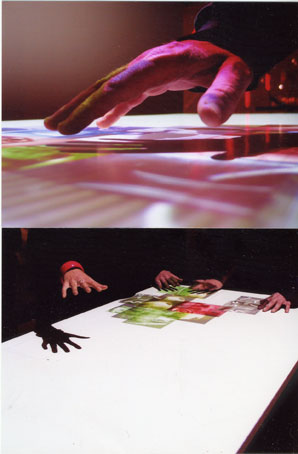"Le Signal" est une installation interactive de Douglas Edric Stanley présentée lors de l'exposition "Ecoute" au Centre Pompidou en Sptembre 2004.
A partir d'un logiciel-auteur, une base de données d'images sonorisées en mouvement est proposé comme potentiel non-linéaire de lecture. L'ensemble est projeté sur l'hypertable où l'utilisateur re-compose le récit avec ses mains. A l'image frontale du cinéma ou de la télévision se substitue une image horizontale et manipulable.Réflexion sur les limites du cinéma traditionnel face aux possibilités offertes par l'art algorithmique
 J'ai lâchement copié/collé un texte écrit par Douglas Edric Stanley que l'on peut trouver par ici
J'ai lâchement copié/collé un texte écrit par Douglas Edric Stanley que l'on peut trouver par ici“The Signal” is a unique audiovisual narrative, designed specifically for the Abstract Machine Hypertable. It maps the mysterious chain of infections that led to a poorly documented telepathic virus that spread throughout the United States of America in a historical period not so far removed from our own. Traces of this virus have been found in the strangest of milieu : in communications technologies, via teenager rituals, in mass media and advertising, through irrigation systems, in sound recordings, in political propaganda and urban myth paranoia, in sociological experiments, etc. “The Signal” charts the virus’ growth across the map of the United States, allowing the Hypertable to transform itself into a sort of war map, overlooking the spread of the contagion.
From a purely technological point of view, The Signal is a unique algorithmic cinema experiment. Over 10,000 video shots were culled from public archives, treated and injected into the Concrescence development software. A narration was added to each image, giving its context in relation to the story. Each image contains its own diegetic sound track, but is accompagnied by narration whenever possible (the program avoids cacaphony by singling out only related narrative information, and tries to give pause between each utterance). One all this data had been entered into the database, the software was then used to literally “teach” the computer the non-linear narrative relationships between the images. This allows the computer to make intelligent choices within the narrative material, in such a way that it can smoothly acompany the unpredictable movements of the public. As each image knows its relationship with other images in the database, it can easily modulate the arrival of new images to match narrative paths coherent with its own. This “concrescence” process is what gave the software platform its name, by the way. “The Signal” was created, therefore, to be one of the first proofs-of-concept of the feasability of the Concrescence platform.
